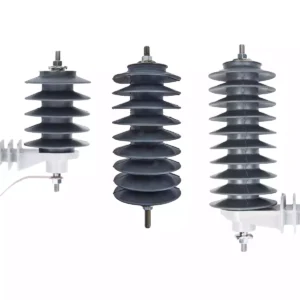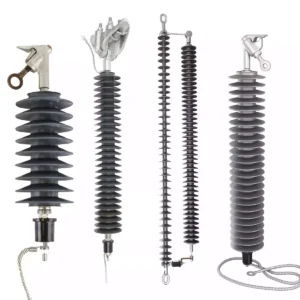Power Surge Arrester
Power surge arrester is a safety device for bypassing or discharging surge current in order to restrict voltage on the equipment. The arresters divert power surge to earth through grounding. They are installed at the service entrance to protect downstream devices. External lightning protection and surge arresters greatly reduce the danger of lightning damage to structures, equipment, and people.
Read More
Surge arreter are of great importance for our safety, but do you know why? Our health, that of our neighbors and the integrity of buildings, for example, are threatened on stormy days and extreme weathers. Consequently, installing this power line hardware-surge arrester and carrying out adequate maintenance and revision tasks is essential.Here, i want to talk about a true story of mine, When i was a little girl, i was so sacred about lightening and storm. In that kind of weather condition, My mom always told me, be careful,do not watch TV in pouring rain, because the lightning will attack you and then it will cause power outage. But nowadays, with the usage of arrester, my mom do not have to worry about my safety and our buildings safety.What is Lightning?
Lightning is a strong natural discharge of static electricity , which is normally produced during an electrical storm that generates an electromagnetic pulse . This electric discharge is accompanied by the emission of light (known as lightning ) caused by the passage of electric current , which ionizes the air molecules; and by the sound of thunder, caused by the shock wave. Electricity passing through the atmosphere rapidly heats and expands the air, producing the characteristic noise of thunder. Lightning can cause different effects: thermal, physiological, electrodynamic or electrochemical, among others. Thermal and physiological are the most important. The thermal effects are due to the high temperature reached by the channel through which the lightning current circulates, leaving temperatures of up to 20,000 degrees; the physiological effects affect living beings and are due to the stresses after the lightning discharge on earth.What is a Surge Arrester and How Does It Work?
A Surge arrester is a metal structure made up of pointed bars that is capable of directing ionizing rays towards the ground so as not to cause damage to people or buildings; at the moment the lightning ‘impacts’ the antenna, the charge is conducted through the wiring to the ground, a path in which the power of the lightning is neutralized . The nature of lightning means that they tend to hit those places that are ‘understood’ to be closer or more accessible. That is why they usually go towards tall vertical sites , such as trees or tall buildings. For this reason, Surge arresters must always be installed above the highest part of the structure to be protected, and will be responsible for safely capturing and channeling the lightning discharge. Surge arresters have a metallic body and a tip connected by a conductive network to a grounding system where the lightning discharge is dissipated . A Surge arrester installation is made up of three elements: a capture electrode, which is the Surge arrester, an electrical ground connection and a cable to conduct the lightning current. Surge arresters seek to prevent lightning from hitting trees or buildings by trying to change their trajectory towards them . They achieve this thanks to two circumstances already mentioned: their location and their composition. In this way, the two main functions of Surge arresters are: to direct ionizing rays and to prevent lightning from causing damage.What is the Approximate Area Covered by a Surge Arrester?
The radius it covers depends on several factors. Among these factors is the type of head, the type of material, the height of the Surge arrester (generally located in high areas of large buildings to increase that height) among others, being able to cover radii of up to 1 km.Surge Protection
Over voltages are voltage rises that can appear on electrical distribution lines that can cause, among other things, damage to equipment connected to the network. Over voltages are produced by direct and indirect atmospheric discharges, disconnection of inductive loads, network commutations and faults in them. Over voltages are large voltage spikes with a steep slope and short duration, even so, their effects on electronic equipment are remarkable. For proper protection of the equipment, a low ohmic value grounding system must be made and connected to the external protection system. Installing external lightning protection and surge protectors considerably reduces the risk of lightning damage to structures, equipment and people.Different Types of Power Surge Arrester
- Low-voltage surge arrester: Apply in Low-voltage distribution system, exchange of electrical appliances protector, low-voltage distribution transformer windings
- Distribution arrester: Apply in 3 kV, 6 kV, 10 kV AC power distribution system to protect distribution transformers, cables and power station equipment
- The station type of common valve arrester: Used to protect the 3 ~ 220 kV transformer station equipment and communication system
- Magnetic blow valve station arrester: Use to 35 ~ 500 kV protect communication systems, transformers and other equipment
- Protection of rotating machine using magnetic blow valve arrester: Used to protect the AC generator and motor insulation
- Line Magnetic blow valve arrester: Used to protect 330 kV and above communication system circuit equipment insulation
- DC or blowing valve-type arrester: Use to protect the DC system’s insulation of electrical equipment
- Neutral protection arrester: Apply in motor or the transformer’s neutral protection
- Fiber-tube arrester: Apply in the power station’s wires and the weaknesses protection in the insulated
- Plug-in Signal Arrester: Used to twisted-pair transmission line in order to protect communications and computer systems
- High-frequency feeder arrester: Used to protect the microwave, mobile base stations satellite receiver, etc.
- Receptacle-type surge arrester: Use to Protect the terminal Electronic equipment
- Signal Arrester: Apply in MODEM, DDN line, fax, phone, process control signal circuit etc.
- Network arrester: Apply in servers, workstations, interfaces etc.
- Coaxial cable lightning arrester: Used on the coaxial cable to protect the wireless transmission and receiving system
What to do During a Thunderstorm?
Experts have concluded that the odds of being struck by lightning are 1 in 3,000,000. However, it is estimated that approximately 24,000 people die annually from lightning, worldwide. This figure includes incidents such as fires; deaths from direct hits are much lower. So, what should you do if you are surprised by a thunderstorm in the open field? The first thing to do is seek shelter. And no, don’t do what first comes to mind: go under a tree. In fact, this is the last thing you should do, as they are one of the places most likely to be struck by lightning. If there is nothing around, the best position to protect yourself from the rays is to sit with your feet together, and with your head against your chest or placed between your knees. Never lie down on the ground, as you will be bigger than lightning. Cover your ears and close your eyes to protect yourself from lightning and wait for the storm to pass. Do you see the importance of the Surge arrester for our safety? Get it at TTF Power System. Contact us for more information about electrical materials in China.


